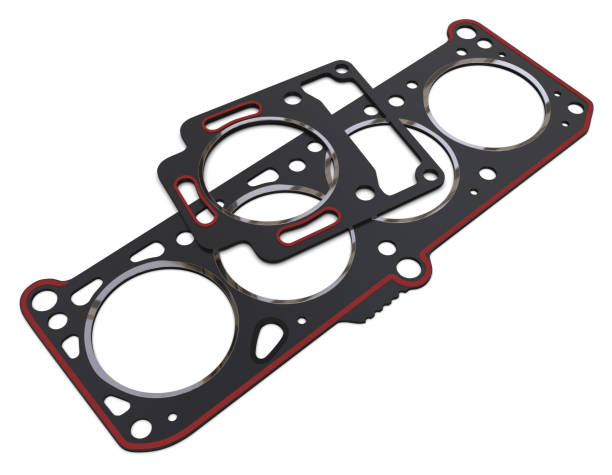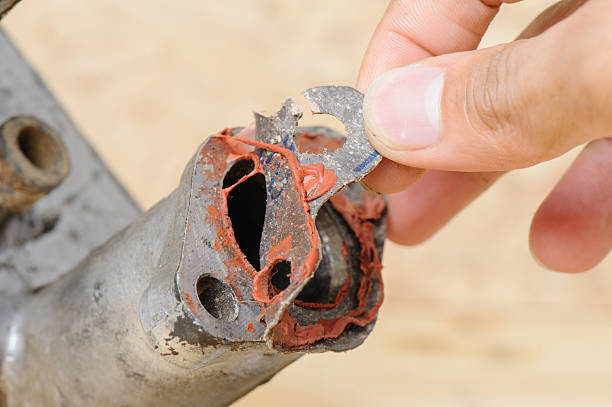what is a head gasket?Comprehensive guidance
The head gasket is a critical component nestled between the engine block (cylinder block) and the cylinder head. It serves as a seal to prevent gases and coolant in the combustion chamber from escaping. This essential part plays a vital role in maintaining engine efficiency and preventing potential damage.
Let’s delve deeper into its location, function, materials, and structure.
Main Functions of the Head Gasket

Seal the Combustion Chamber
High-Pressure Barrier: During combustion, high-pressure gases are generated in the cylinder. The cylinder head gasket must withstand these pressures to prevent leaks between the cylinder head and the cylinder block. The sealing performance directly affects the engine’s power output and fuel economy.
Separate Fluids
Prevent Mixing: The cylinder head gasket prevents coolant (usually a mixture of water and antifreeze) from mixing with engine oil. Mixing can lead to performance deterioration, corrosion, and contamination, impacting the life and performance of engine components.
Maintaining Pressure
Turbocharged Engines Dependence: Cylinder head gaskets help maintain cylinder pressure, crucial for turbocharged engines relying on precise pressure control for efficiency and performance. Good pressure maintenance improves thermal efficiency and reduces energy loss.
Temperature Regulation
Optimal Operating Temperature: By sealing the combustion chamber and water jacket, head gaskets ensure coolant effectively absorbs and transfers heat, helping the engine maintain optimal operating temperature. Failure can lead to coolant leaks, engine overheating, and component damage.
Reduce Noise and Vibration
Absorb Shock and Vibration: Cylinder head gaskets also reduce engine noise and vibration by absorbing some of the shock and vibration generated by the combustion process.
Head Gasket Materials and Structure
Cylinder gasket materials typically consist of metal, rubber, or composite materials. As automobile technology advances, so do their design and function. Different materials and structures cater to various engine types. Common types include:

Metal Asbestos Gasket
Heat Resistance and Chemical Corrosion Resistance: With asbestos as the matrix, it features copper or steel sheets on the outside and metal wire or shavings in the middle for enhanced thermal conductivity and temperature balance. This type offers good elasticity and heat resistance, making it widely used.
Metal Sheet Cylinder Gasket
Thermal Conductivity and Strength: Stamped from low-carbon steel or copper sheets, these gaskets are used in high-strength engines. To ensure better sealing, flanges are stamped around water, oil, and combustion chamber holes. They generally last for 2-3 uses.
Metal Skeleton-Asbestos Gasket
Adaptability to Unevenness and Deformation: Using metal mesh or punched steel plates as the skeleton, covered with asbestos and adhesive. Surfaces are coated with lubricants like graphite powder, with metal edging around critical holes. This type offers good elasticity and adaptability. Due to the adhesive, special attention is needed for cleaning and maintenance during installation and removal.
Causes of Head Gasket Failure

Overheating: Prolonged exposure to high temperatures degrades the gasket material. Overheating can stem from cooling system issues or incomplete combustion, accelerating material aging and reducing sealing performance.
Excessive Engine Wear: Over time, engine components wear, leading to an imperfect seal. Factors like cylinder head lift, bolt axial force, and liner protrusion affect sealing performance. Excessive wear can cause gasket failure.
Physical Damage: Misalignment or improper installation can damage the gasket. Inadequate compression due to improper bolt tightening can lead to gas leaks and gasket damage.
Stretching or Loosening of Bolts and Nuts: Extrusion deformation and pressure from high-pressure gases can cause bolts and nuts to stretch or loosen, leading to gas leaks and gasket damage.
Chemical Erosion: Many coolants lack engine manufacturer approval, containing aggressive additives that damage sealing materials and cause leaks. So do leak-stoppers, causing sealing material swelling and eventual destruction.
Improper Installation and Maintenance: Insufficient bolt torque or incorrect gasket protrusion adjustment can damage the cylinder head gasket.
Symptoms of a Failed or Blown Head Gasket

- High Engine Temperature: Overheating is a primary reason for cylinder head gasket failure.
- Excessive Cooling System Pressure: Loop hoses are under great pressure and may rupture.
- High Water or Oil Consumption: Sudden increases in oil or water consumption indicate a potential gasket issue.
- White or Gray Smoke from the Exhaust System: Indicates the presence of coolant or oil in the cylinder due to seal failure.
- Brown Coolant: Oil entering the cooling circuit turns the coolant brown.
- Rising Oil Level: Coolant in the lubrication system raises the oil level.
- Coolant Leaking from Under the Exhaust Manifold: External leaks are a sign of gasket failure.
- White Smoke from the Exhaust Pipe: Suggests coolant entering the combustion chamber.
- Bubbles in the Radiator or Coolant Overflow Tank: Indicate a leak in the cooling system.
- White Milky Oil: A mixture of oil and coolant.
- Large Loss of Coolant without Obvious Leakage: Hidden leaks can be costly.
Consequences of a Blown Head Gasket

- Degraded Engine Performance: Mixing coolant and oil affects lubrication and cooling, reducing performance.
- Cooling System Problems: Leaks prevent the cooling system from functioning, leading to overheating and engine damage.
- Emission Problems: Leaks cause high-pressure gas to enter the cooling system, affecting performance and causing emissions to exceed standards.
- Safety Hazards: Abnormal vibrations and deviations during driving compromise stability and safety, increasing accident risks.
- Damage to Other Components: Further damage increases repair costs.
- Uneven Tire Wear: Affects tire life and can cause accidents at high speeds.
- Reduced Driving Comfort: Noise during driving detracts from comfort.
Timely resolution of head gasket issues is crucial to avoid further engine problems and expensive repairs.
Repair or Replace the Head Gasket
Repairing or replacing the head gasket requires professional skills and tools. Here are some basic steps and precautions:

- Removing the Cylinder Head: Involves multiple steps, including removing intake and exhaust pipes and accessories to access the gasket.
- Clean the Surface: Ensure the contact surface between the cylinder head and block is clean for better sealing.
- Install the New Gasket: Place the new gasket, ensuring alignment for optimal sealing.
- Reset the Cylinder Head: Follow manufacturer torque specs to reset and tighten bolts evenly.
- Reinstall Other Accessories: Carefully reinstall removed parts, ensuring correct installation and fixation.
- Use High-Temperature Sealant: use of a head gasket sealer to ensure a proper seal,Apply a layer of high-temperature sealant to enhance sealing when installing new gaskets.
- Tighten Screws in Diagonal Order: Ensure even force distribution to prevent gasket damage.
- Inspection and Testing: Conduct coolant leak and engine pressure tests post-replacement to ensure proper installation and no leaks.
Given the complexity of the head gasket replacement process, it’s highly recommended to have a professional automotive repair technician handle the job. This ensures that the work is done correctly and safely, saving you from potential complications and additional costs down the line.
Preventive Maintenance of Head Gaskets
To maintain the head gasket and extend its service life:
- Regularly inspect and maintain the engine’s cooling system.
- Use high-quality coolant and replace it according to the manufacturer’s recommendations.
- Monitor engine temperature and address overheating issues promptly.
- Regular engine maintenance and early detection of head gasket problems can prevent costly repairs and extend engine life.
Conclusion
The cylinder head gasket is a key component of engine health. It ensures a proper seal, prevents fluid contamination, and maintains engine temperature. By understanding the importance of the head gasket and taking proactive steps in its maintenance, you can avoid costly repairs and ensure your vehicle runs smoothly. Don’t let a small part like a head gasket cause big trouble; be proactive in taking care of it.


